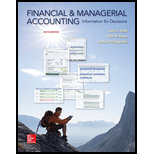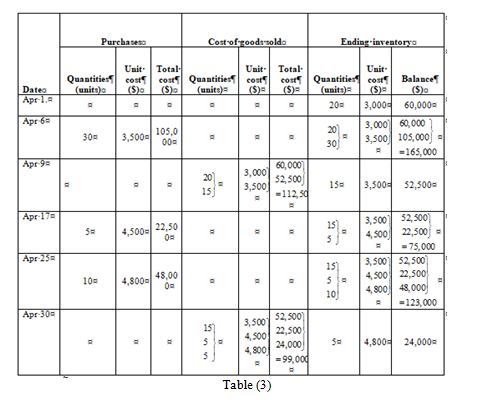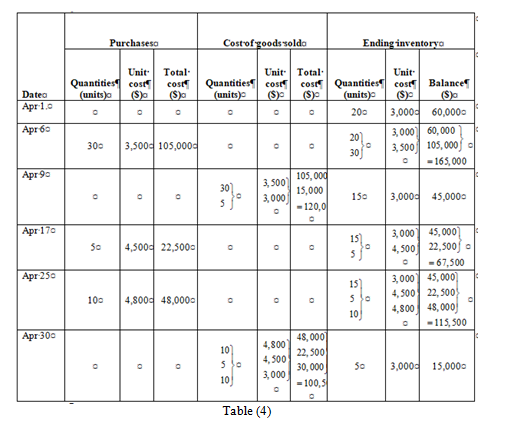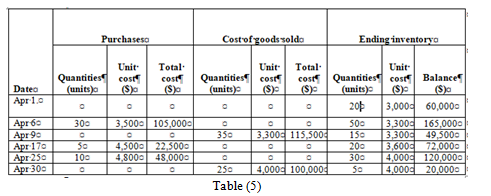
Concept explainers
Inventory
Inventory refers to the stock or goods which will be sold in the near future and thus is an asset for the company. It comprises of the raw materials which are yet to be processed, the stock which is still going through the process of production and it also includes completed products that are ready for sale. Thus inventory is the biggest and the important source of income and profit for the business.
Perpetual Inventory System
In perpetual inventory system there is a continuous recording of transactions as and when they take place that is purchase and sale transactions are recorded whenever they occur.
Cost of Goods Available for Sale
It basically includes the cost of inventory which is ready for sale within an accounting period. It mainly includes the cost of beginning inventory as well as the stock purchased in that year and the production within that period (if any).
Cost of Goods Sold
Cost of goods sold is the total expenses or the cost incurred by the business during the process of manufacturing of goods and is directly related to the production. It generally includes the cost of raw material, labor and other
Gross Profit
The profit made after subtracting or debiting the costs related to the goods sold from the total revenue earned or made through sales in a fiscal year is the gross profit.
First in First out
In case of first in, first out method, also known as FIFO method, the inventory which was bought first will also be the first one to be taken out.
Last in First out
In case of last in, first out, also known as LIFO method, the inventory which was bought in the last will be taken out first.
Weighted Average Cost Method
In this method the weighted average cost is evaluated after any purchases have been made and transactions are recorded as when purchase or sales take place.
Specific Identification Method
Under this method, there is a continuous tracking of the inventory and the inventory cost at the time of purchase on the basis of unique identity which thus helps in the valuation of the ending inventory as well as the cost of goods sold. This method is used generally when the company is involved in limited expensive goods which are easily identifiable.
To compute: 1. Cost of goods available for sale and number of units available for sale.
2. Number of units in ending inventory.
3. Cost of ending inventory under the following methods:
- (a) FIFO
(b)LIFO
(c) Weighted average
(d) Specific identification
Given info,
| Date | Particulars | Units acquired | Cost per unit ($) | Units sold | Retail price per unit ($) |
| Apr 1 | Beginning inventory | 20 | 3,000 | ||
| Apr 6 | Purchase | 30 | 3,500 | ||
| Apr 9 | Sales | 35 | 12,000 | ||
| Apr 17 | Purchase | 5 | 4,500 | ||
| Apr 25 | Purchase | 10 | 4,800 | ||
| Apr 30 | Sales | 25 | 14,000 | ||
| Total | 65 | 60 |
The ending inventory consists of 5 units from April 17.
Explanation of Solution
1.
Cost of goods available for sale
Formula to calculate Cost of goods available for sale is,
Cost and units of goods available for sale:
| Particulars | Number of units | Cost per unit ($) | Amount ($) | |
| Beginning Inventory | 20 | 3000 | 60,000 | |
| Purchases: | ||||
| April 6 | 30 | 3,500 | 105,000 | |
| April 17 | 5 | 4,500 | 22,500 | |
| April 25 | 10 | 4,800 | 48,000 | |
| Total Purchases | 45 | 175,500 | ||
| Available for sale | 65 | 235,500 | ||
| Table (1) | ||||
(2)
Number of units in ending inventory
| Particulars | Number of units | |||
| Number of units available for sale (given) | 65 | |||
| Less: units sold (given) | 60 | |||
| Number of units in ending inventory | 5 | |||
| Table (2) | ||||
The number of units in ending inventory is 5 units.
3.
(a)
First in, First out method (FIFO)
Ending inventory

| Date | Purchases | Cost of goods sold | Ending inventory | ||||||
| Quantities (units) | Unit cost ($) | Total cost ($) | Quantities (units) | Unit cost ($) | Total cost ($) | Quantities (units) | Unit cost ($) | Balance ($) | |
| Apr 1. | 20 | 3,000 | 60,000 | ||||||
| Apr 6 | 30 | 3,500 | 105,000 | | | | |||
| Apr 9 | | | | 15 | 3,500 | 52,500 | |||
| Apr 17 | 5 | 4,500 | 22,500 | | | | |||
| Apr 25 | 10 | 4,800 | 48,000 | | | | |||
| Apr 30 | | | | 5 | 4,800 | 24,000 | |||
| Table (4) | |||||||||
Cost of goods sold
Formula to calculate cost of goods sold is,
Substitute $235,500for cost of goods available for sale (calculated in part (1)) and $24,000 for cost of ending inventory (as calculated above in the table) in the above formula.
Under FIFO method, the amount of ending inventory is $24,000 and cost of goods sold is $211,500.
(b)
Last in, first out method (LIFO)
Ending inventory

| Date | Purchases | Cost of goods sold | Ending inventory | ||||||
| Quantities (units) | Unit cost ($) | Total cost ($) | Quantities (units) | Unit cost ($) | Total cost ($) | Quantities (units) | Unit cost ($) | Balance ($) | |
| Apr 1. | 20 | 3,000 | 60,000 | ||||||
| Apr 6 | 30 | 3,500 | 105,000 | | | | |||
| Apr 9 | | | | 15 | 3,000 | 45,000 | |||
| Apr 17 | 5 | 4,500 | 22,500 | | | | |||
| Apr 25 | 10 | 4,800 | 48,000 | | | | |||
| Apr 30 | | | | 5 | 3,000 | 15,000 | |||
| Table (6) | |||||||||
Cost of goods sold
Formula to calculate cost of goods sold is,
Substitute $235,500for cost of goods available for sale (calculated in part (1)) and $15,000 for cost of ending inventory (as calculated above in the table) in the above formula.
Under LIFO method, the amount of ending inventory is $15,000 and cost of goods sold is $220,500.
(c)
Weighted Average Method
Ending inventory

| Date | Purchases | Cost of goods sold | Ending inventory | ||||||
| Quantities (units) | Unit cost ($) | Total cost ($) | Quantities (units) | Unit cost ($) | Total cost ($) | Quantities (units) | Unit cost ($) | Balance ($) | |
| Apr 1. | 20 | 3,000 | 60,000 | ||||||
| Apr 6 | 30 | 3,500 | 105,000 | 50 | 3,300 | 165,000 | |||
| Apr 9 | 35 | 3,300 | 115,500 | 15 | 3,300 | 49,500 | |||
| Apr 17 | 5 | 4,500 | 22,500 | 20 | 3,600 | 72,000 | |||
| Apr 25 | 10 | 4,800 | 48,000 | 30 | 4,000 | 120,000 | |||
| Apr 30 | 25 | 4,000 | 100,000 | 5 | 4,000 | 20,000 | |||
| Table (8) | |||||||||
Working Notes:
Calculation of weighted average cost per unit:
Cost of goods sold
Formula to calculate cost of goods sold is,
Substitute $235,500for cost of goods available for sale (calculated in part (1)) and $20,000 for cost of ending inventory (as calculated above in the table) in the above formula.
Under weighted average method, the amount of ending inventory is $20,000 and cost of goods sold is $215,500.
(d)
Specific identification method
Given info,
The ending inventory consists of 5 units from April 17.
Cost of Ending Inventory
| Date of Purchase | Number of units (A) | Cost per unit ($) (B) | Amount ($) | |
| April 17 | 5 | 4,500 | 22,500 | |
| Cost of Ending Inventory | 22,500 | |||
| Table (9) | ||||
Cost of goods sold
Formula to calculate cost of goods sold is,
Substitute $235,500for cost of goods available for sale (calculated in part (1)) and $22,500 for cost of ending inventory (calculated above in the table) in the above formula.
The cost of ending inventory is $22,500 and the cost of goods sold is $213,000.
4.
Sales are $770,000 (working notes).
Cost of goods sold in case of FIFO is $211,500. (Calculated in part (3(a))
Cost of goods sold in case LIFO is $220,500.(Calculated in part (3(b))
Cost of goods sold in case of weighted average is $215,500 and (Calculated in part (3(c))
Cost of goods sold in case of specific identification is 213,000.(Calculated in part (3(d))
Gross Profit
Formula to calculate gross profit is,
| Particulars | FIFO | LIFO | Weighted average | Specific identification |
| Sales(working notes) | $770,000 | $$770,000 | $770,000 | $770,000 |
| Less: Cost of goods sold | $211,500 | $220,500 | $215,500 | $213,000 |
| Gross profit | $558,500 | $549,500 | $554,500 | $557,000 |
| Table (10) | ||||
Working notes:
Calculation of sales
The gross profit in case of FIFO it is $558,500, of LIFO it is $549,500, of weighted average it is $554,500 and of specific identification it is $557,000.
Want to see more full solutions like this?
Chapter 5 Solutions
Financial and Managerial Accounting: Information for Decisions
- Could you help me solve this financial accounting question using appropriate calculation techniques?arrow_forwardCaldwell Electronic Devices produces smartphone accessories. Estimated sales (in units) are 62,000 in July, 54,000 in August, and 49,500 in September. Each unit is priced at $35. Caldwell wants to have 45% of the following month's sales in ending inventory. That requirement was met on July 1. Each accessory requires 3 components and 8 feet of specialized cabling. Components cost $4 each, and cabling is $0.75 per foot. Caldwell wants to have 30% of the following month's production needs in ending raw materials inventory. On July 1, Caldwell had 45,000 components and 120,000 feet of cabling in inventory. What is Caldwell's expected sales revenue for August?arrow_forwardEinstein 2023 balance sheet showed net fixed assets of $3.1 million, while its 2022 balance sheet showed net fixed assets of $2.9 million. Its 2023 income statement reported a depreciation expense of $280,000. How much did Jason spend to acquire new fixed assets during 2023?arrow_forward
- I am looking for the correct answer to this general accounting question with appropriate explanations.arrow_forwardJacobson Co. recently reported a net income of $7,840 and depreciation of $1,250. How much was its net cash flow, assuming it had no amortization expense and sold none of its fixed assets? provide answerarrow_forwardWhat is the value of valid returns of each averages $215?arrow_forward
- I need help finding the accurate solution to this financial accounting problem with valid methods.arrow_forwardCan you solve this general accounting problem using accurate calculation methods?arrow_forwardPlease show me the correct approach to solving this financial accounting question with proper techniques.arrow_forward
- What was the amount of the net income for the year?arrow_forwardBased on potential sales of 800 units per year, a new product at Waverly Manufacturing has estimated traceable costs of $1,600,000. What is the target price to obtain a 25% profit margin on sales? A. $2,500.68 B. $2,400.21 C. $2,666.67 D. $1,950.55arrow_forwardHi expert please given correct answer with accountingarrow_forward

 AccountingAccountingISBN:9781337272094Author:WARREN, Carl S., Reeve, James M., Duchac, Jonathan E.Publisher:Cengage Learning,
AccountingAccountingISBN:9781337272094Author:WARREN, Carl S., Reeve, James M., Duchac, Jonathan E.Publisher:Cengage Learning, Accounting Information SystemsAccountingISBN:9781337619202Author:Hall, James A.Publisher:Cengage Learning,
Accounting Information SystemsAccountingISBN:9781337619202Author:Hall, James A.Publisher:Cengage Learning, Horngren's Cost Accounting: A Managerial Emphasis...AccountingISBN:9780134475585Author:Srikant M. Datar, Madhav V. RajanPublisher:PEARSON
Horngren's Cost Accounting: A Managerial Emphasis...AccountingISBN:9780134475585Author:Srikant M. Datar, Madhav V. RajanPublisher:PEARSON Intermediate AccountingAccountingISBN:9781259722660Author:J. David Spiceland, Mark W. Nelson, Wayne M ThomasPublisher:McGraw-Hill Education
Intermediate AccountingAccountingISBN:9781259722660Author:J. David Spiceland, Mark W. Nelson, Wayne M ThomasPublisher:McGraw-Hill Education Financial and Managerial AccountingAccountingISBN:9781259726705Author:John J Wild, Ken W. Shaw, Barbara Chiappetta Fundamental Accounting PrinciplesPublisher:McGraw-Hill Education
Financial and Managerial AccountingAccountingISBN:9781259726705Author:John J Wild, Ken W. Shaw, Barbara Chiappetta Fundamental Accounting PrinciplesPublisher:McGraw-Hill Education





